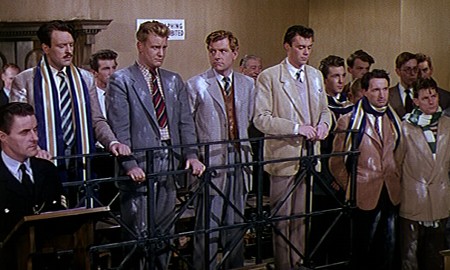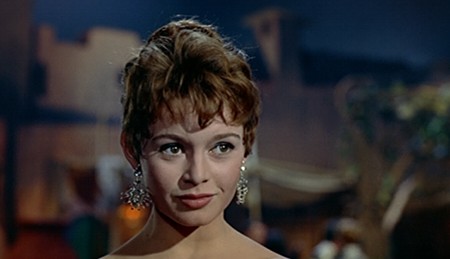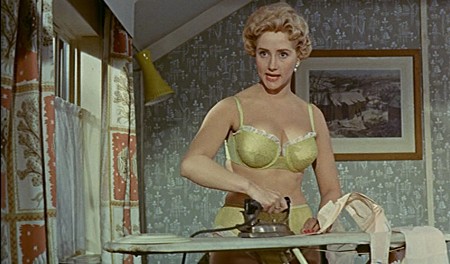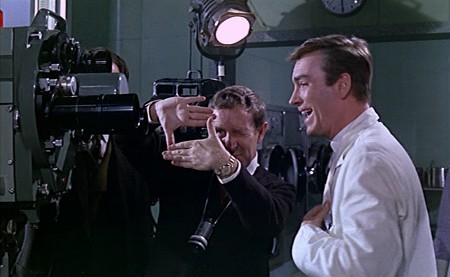Doctor in the House: The Films
Nowadays, thank the Lord, the British look back on their film industry with pride, hence the stunning amount of information one can get about the Carry On films. However, not everyone remembers the series of films (as well as the TV series) which sprung from the Doctor In the House novels, written by Richard Gordon. As is common in the film making business, the films are related in terms of their producer; Peter Rogers for the Carry Ons, and his wife Betty E. Box for the Doctor films. As the series of films was made over a 16 year period, starting in 1954, they can also be used, as can the Carry Ons, to illustrate the fast pace of social change in 1950s and '60s Britain. The first film is very different to the last in many ways, as a cursory glance at the DVD covers can bear out, but are the films more than just period pieces? Was my £10 for the box set of seven well spent? I decided to sit down and watch them all...
The series, begins, naturally, with Doctor In the House, made in 1954. This stars Dirk Bogarde as Simon Sparrow, the wide-eyed medical student who is the hero of the piece, and who falls in with a group of older students who have all been kept down a year because they're so lazy, played by Donald Sinden (I had trouble spotting him), Donald Houston and Kenneth More. The film follows their quest for qualification in a fairly genial fashion, and Bogarde is utterly charming as Sparrow, struggling to maintain his properity in the face of a over-friendly landlady's daughter and the antics of his friends. The film also stars the respected actor and man of many talents, James Robertson Justice, as Sir Lancelot Spratt, who struggles with Bogarde to steal the film. Muriel Pavlow is splendid as the nurse whom Sparrow ends up dating, and it's a shame that she isn't more well known. It's interesting to see the comparison with Joan Sims as the repressed nurse Rigor Mortis in this film, as it seems that character actresses, at least in the past, tended to make more of an impression on the public. It's a great start to the series, with bucketloads of charm and action, and it gave me a good impression for the rest of the films.

Doctor in the House: The student of St Swithins' Hospital get into trouble.
The second film, Doctor at Sea, features the newly qualified Sparrow taking a job on a cargo ship in an effort to get away from women, prompted by the efforts of his first employer to marry him off to his plain, but keen, daughter, played by Joan Sims. Sparrow soon finds himself having to adjust to ship life, including seasickness (in himself), a ship's carpenter who has 'funny turns', cured by alcohol, and a unsympathetic Captain Hogg, played (funnily enough) by James Robertson Justice. Presumably Betty Box assumed that the audience would be intelligent enough to tell the difference, which puts her firmly above most Hollywood producers. The captain is determined to run an orderly ship, which means having no chicks on board; "I don't approve of women, they're unseamanlike and unnecessary." Unfortunately for the captain, on docking at Belos in Algeria, the owner of the shipping company, Sir Arthur, is determined that Captain Hogg take his daughter on board from a boat run by Hogg's rival Captain Beamish. More trouble occurs when some of the crew go on shore leave and, after a night in which Sparrow gets to know a nightclub singer, played by Brigitte Bardot, the crew land up in the police cells for the night. Luckily, they are set free in the morning, and as said singer is a friend of Sir Arthur's daughter, she travels back with the boat, unearthing Sparrow from his cabin. This was Brigitte's first appearance for British audiences, and you can see why young British men went crazy for her, frankly. Doctor at Sea is an entertaining yarn, with some seriously good eye candy, but one can't help but feel that it could do with a bit of a trim here and there, even if the cast give marvellous performances.

Doctor at Sea: Brigitte Bardot drives the blokes wild.
The third film in the series, Doctor at Large, sees Simon Sparrow back at St Swithun's, with Joy, the nurse he had a romance with in Doctor in the House, studying to be a doctor, and a reasonable amount of the film is devoted to her attempts to pass her exams and failing, despite her idea to wear plain glasses in order to look intelligent. After failing to win the heart of a glamourous nurse because he failed to get the house surgeon post, Sparrow leaves for a post in a Midlands surgery, but encounters his old trouble with predatory women (what is it about these places?), with the senior partner's wife trying her hardest to get into bed with him. With the senior partner concerned a very odd man indeed, you can hardly blame her, and his hinting that he murdered previous incumbents of the junior post, presumably for nobbing his missus, is quite enough for Sparrow. A post signing a rich old lady's presciptions fails to excite him, and he falls on his feet when he joins a private practice to cover for the other partner, who is travelling. Naturally, all the well-to-do lady patients adore him, but the post doesn't last forever, and Sparrow finds himself in a rural practice in Scotland, where his aspirations to be a surgeon leads him right back to St Swithuns.
Due to a hilariously unlikely setup with a group of elephants and House Surgeon Bingham, and Sir Lancelot Spratt overhearing Sparrow telling a patient why he became a doctor, Sparrow becomes House Surgeon instead. He also becomes engaged to Joy, who's given up all this book-learning rubbish, and presumably sates her desire for medicine by getting married to a doctor instead. Doctor at Large is a perfectly charming film, with Bogarde and Robertson Justice fighting for supremacy again, but as you can probably tell, plot-wise, it seems to resemble the road sign I saw in Wales recently, showing a winding road and the information plate 'For Miles' underneath. It's not really clear why we need to see Sparrow making his way round the GP surgeries of Britain, and one feels that the desire for Sparrow to be a house surgeon could have been established in fewer settings, with more good jokes. The best sequence is the first one, with Dilys Laye playing a convincing love-starved wife, and Lionel Jefferies as the distinctly sinister doctor, but sadly the rest of the film doesn't really hit those heights again.
I really wanted to like Doctor in Love, the fourth film in the series. The supporting cast is sublime; Joan Sims, Liz Fraser, Irene Handl, John Le Mesurier, Esme Cannon, Fenella Fielding, Nicholas Parsons, Joan Hickman, and Peter Sallis in a very amusing cameo appearance. However, this fine bunch are rather let down by the dull performances of Michael Craig and Leslie Phillips as doctors Burke and Hare. Bogarde had felt himself too grown-up for Sparrow, but he would have certainly done a better job, due to his greater charm and presence, because Craig is just too serious for the part. Bogarde brought a warmth to the Sparrow role, which other actors may have struggled with. As sidekick to Phillip's usual eyebrow-waggling shtick, Craig just looks a bit infantile and silly, and I ended being rather bored by the two of them. It's great to have Irene Handl playing against type as a stern professor, and Joan and Liz are a delight as two bored strippers, but the film totally exhausted my patience by finishing with a rather feeble love story. Virginia Maskell plays doe-eyed Dr Barrington, who ends up looking concerned at a desperately sick boy's bedside whilst Burke fights the authorities, and the boy's father, in order to give the lad a miracle drug, which of course cures him. Obviously, even in 1960, Dr Barrington agreeing to marry Burke would have been a touch too predictable, so the plot introduces an ex-girlfriend of Burke's to cause trouble until the inevitable making-up and engagement. It's a missed opportunity, frankly, which I think is a great shame. Even the theme tune, the most horrible bit of jazz I've ever heard, smacks of being ill-thought through.

Doctor in Love: Liz Fraser in her underwear, there.
Thankfully, Doctor in Distress is a lot more fun, partly because Dirk Bogarde returns as Sparrow, and because the writer obviously has no respect for continuity, bringing Lancelot Spratt back, and totally forgetting about the existence of Spratt's wife. The film starts with what was seemingly a new custom of laying credits over film sequences, which looks delightful, even if the DVD is made from a poor print of the film, and there is, thankfully, a return to an orchestral theme. The love interest for Spratt is a physiotherapist, who is also treating a paralysed Major, and the two compete for her affections. Well, Spratt competes once he realises he's interested, and we're meant to believe that he's a complete novice at this type of thing, which, to be fair, Robertson Justice does a good job at doing, and brings a more rounded portrayal of Spratt than previously. Bogarde and Robertson Justice make the film, as usual, with Sparrow's house surgeon status making for far more entertaining exchanges of dialogue than before. Nudges at sexism, first hinted at Doctor at Large, are here as well, with a female medical student being included in the term 'gentlemen'. The physiotherapist is actually a rather good female role model, which makes a nice change, especially as Amanda Barrie is playing her usual cheeky good-time girl role, and shows the physiotherapist making her own decision over who wins her heart. Rather surprisingly, it's not Spratt, which makes one wonder why the whole plot hung on the supposed love story between her and him. It's not actually clear, either, whether the Major's recovery from paralysis is a recovery, or whether he's just been pretending for sympathy, and his intended is too in love to care. However, this wasn't the only love story going on, with Sparrow having an on-off romance with a model (wasn't he getting married in Doctor at Large? Oh well), and dabbling with a French keep-fit fanatic.
Doctor in Distress is perhaps one of the best films in the series, with some brilliant performances from the leads, and nice cameos from Peter Butterworth, Johnny Briggs, Richard Briers, Denise Coffey, Fenella Fielding, and, perhaps most surprisingly, Ronnie Barker, who manages to light up the screen with his short appearance. However, Bogarde couldn't carry on forever, and the gauntlet is passed onto Leslie Phillips in Doctor in Clover, who plays essentially the same character as in Doctor in Love, but this time is called Gaston Grimsdyke. He's given the sack from being a prison's doctor due to him having a fling with the governor's daughter, and is accepted back to St Swithun's by Lancelot Spratt, who intends to re-train him, much to the annoyance of Gaston's cousin, who is already a doctor there. Joan Sims also stars as the formidable new matron, who doesn't see eye to eye with Spratt, and Elizabeth Ercy is introduced to British audiences as the pretty young physiotherapist Jeannine, who Gaston spectacularly fails to get off with.

Doctor in Clover: Your camera equipment in their hands.
Medical high-jinks ensue with laughing gas at a hospital party, an over-used hospital swimming pool, and a Your Life in Their Hands parody, where the TV crew are shown as pushy young upstarts. No doubt this was the opinion of the increasingly jumpy film industry in 1966, although it is amusing to see the large number of actors in this film who had established television careers at this point, such as Dandy Nichols, Arthur Haynes, Wendy Richards and Terry Scott. By this point, the ensemble cast which appeared in the early films has more or less gone, although Fenella Fielding pops up at the start of the film as a very silly ballet dancer, and James Robertson Justice carries on his grand tradition of being possibly the best thing about the film. Despite the fact that it's essentially a lot of messing about, Doctor in Clover is fun to watch, and Leslie Phillips benefits from playing the only stupid arse in the film, rather than having to share the priviledge. His angst about his age being disproved by being denied a promotion because he looks too young, is but a distraction from the rest of the activities, which is probably just as well. Just ignore the truly terrible title song, sang by Kiki Dee, and the slightly dodgy reversal of film during the titles, and you'll have fun.
As with the Carry On series, the Doctor series had to cope with changing social mores during the 1960s, and I did think that Doctor in Trouble, made in 1970, might have suffered from trying to cram in as much sexual liberation as possible. The two series seem to converge at this point, with the title theme being written by Eric Rogers, who appears to have cut together every Carry On theme he wrote to accompany the rather lovely title sequence. My hopes for the film were given a boost by the realisation that Harry Secombe, Irene Handl, Graham Chapman, Jacki Piper and Graeme Stark were all in the cast, even if Stark does play a cut-price Sellers as Satterjee, the ship's Indian Bellman. This time, Leslie Phillips, for some reason, goes back to playing Dr Burke (keep up), who is pursing a model, Ophelia (a spirited performance from Angela Scoular), who is going on a cruise to be photographed. Simon Dee (yes, that Simon Dee) plays an actor, Basil Beauchamp, who stars as Dr Dare in a popular TV drama, and is admitted to St Swithuns, where Spratt recommends a cruise in order for him to get some rest. Dr Burke is trying to get Ophelia to marry him so he can take up a job in the US, and follows her on to the ship in a last-ditch attempt to get a commitment from her before she sails. However, because he has to sneak onto the ship, he ends up being an unwitting stowaway. Although he manages to evade the Security Officer (Quartermaster?) for a while, Beauchamp grasses him up to the authorities, and Burke has to work for his keep, including being transferred, via breeches buoy, to take an appendix out on a Soviet ship, with Joan Sims as the captain. Burke has to return home on this ship, and finds out that Ophelia has already married when she disembarkes, because Burke didn't ask her. Doh!

Doctor in Trouble: Graham Chapman, doing his bit for gay rights.
Doctor in Trouble certainly has clear signs of the production team crowbarring in as many cliches of the sexual revolution as possible, with bare breasts, swearing, and Graham Chapman camping it up like anything, but this doesn't distract from the strong performances from Secombe as Llewellyn Wendover, a pools winner (he puts in a similar performance in The Magnificent Seven Deadly Sins, directed by Stark), and Handl as a stripper's mum, who is determined to get her married for money. Simon Dee is also very good as the self-absorbed Basil Beauchamp, and has made me keen to see more of his work. The main problem with the film is that it's just too long, with the Soviet ship segment being fairly pointless, and in fact all the Doctor films could have done with the discipline of the strongest Carry Ons, which didn't outstay their welcome.
Someone on IMDB has identified Geoffrey Davies playing Dick Stuart-Clark from the TV series in this film, and has concluded that perhaps a film version of the TV series was planned, but if this is true, it was probably just as well that it wasn't made, as most of the jokes that could be extracted from the Doctor stories had been cracked by this point. Although Doctor in Trouble isn't a bad way to end the film series, and it's a lot better than I feared from the cover, there isn't really anywhere else for the series to go, signified by the fact that Doctor in Trouble is really a reprisal of Doctor at Sea, albeit with added tits. On the whole, the films get by on the charm of the main actors, which is no bad thing in itself, but it must be said that the Carry Ons, on the whole, are a bit stronger, by virtue of them being able to do more things with the format, and by them being made with rather more discipline. If you're into silly jokes and good old-fashioned British fun, though, you won't be disappointed.
A version of this article first appeared in The Kettering.
About this entry
- By Tanya Jones
- Posted on Wednesday, May 20 2009 @ 12:11 am
- Categorised in Film, Analysis
- Tagged with doctor in the house, comedy
- 0 comments
